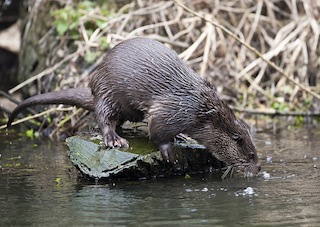 The shy Otter can be hard to spot, but look for its spraints along river courses and by the coast.
The shy Otter can be hard to spot, but look for its spraints along river courses and by the coast.
Photo: ©Natural England/Allan Drewitt
Scientific name: Lutra lutra
Other common names: Eurasian Otter, European Otter, River Otter, Common Otter
Cornish name: Dowrgi
Conservation status: IUCN Red List, Near Threatened; UK Biodiversity Action Plan, Priority Species.; listed in Cornwall and Isles of Scilly Red Data Book
What to look for:
- Appearance and colouring : Brown fur that looks darker when wet, with paler chest; long tail, tapering towards end; short legs and long lithe body; webbed feet. Only the top of their head is held above the water when swimming.
- Size : Up to 1.2 m length (males) and 1.1 m (females).
- Where : Freshwater, and also coastal habitats with access to freshwater.
- Similar species : The non-native American Mink, which is much smaller (c. 0.65 m long) and darker in colouring, but can be confused with the Otter as the latter looks smaller when swimming through the water.
 The Otter is a creature that is making it back from the brink in the UK. Pollution of their freshwater habitats in the second half of the twentieth century caused a dramatic decline in numbers across the country. Action to clean up water catchments since then has enabled the Otter to make a comeback. Indeed, in Cornwall, fighting between Otters for resources and territory suggests that the population is now approaching healthy levels.
The Otter is a creature that is making it back from the brink in the UK. Pollution of their freshwater habitats in the second half of the twentieth century caused a dramatic decline in numbers across the country. Action to clean up water catchments since then has enabled the Otter to make a comeback. Indeed, in Cornwall, fighting between Otters for resources and territory suggests that the population is now approaching healthy levels.
It might be an iconic and familiar mammal, but the Otter can be hard to spot. Mainly nocturnal, it is also shy of humans, slipping quickly into its watery habitat when disturbed.
Otters eat fish and eels, as well as amphibians. They use their musk-scented spraints as territorial markers: you can usually see fish scales and bones in the spraint. Females breed from their second year, usually producing a litter of one or two cubs, which they rear without help from the male.
Did you know…?
…Henry Williamson’s Tarka the Otter is thought to have been inspired by J.C. Tregarthen’s 1909 book, written in Cornwall, The Life Story of an Otter (Cornwall Mammal Group, 2013)
…Road deaths are the most common cause of Otter mortality in Cornwall.
More information and references:
Cornwall Mammal Group, 2013. The Mammals of Cornwall and the Isles of Scilly (edited by David Groves). Environmental Records Centre for Cornwall and the Isles of Scilly (ERCCIS), Cornwall.
Published: December 2014
Author: Amanda Scott
Photo: ©Natural England/Allan Drewitt
